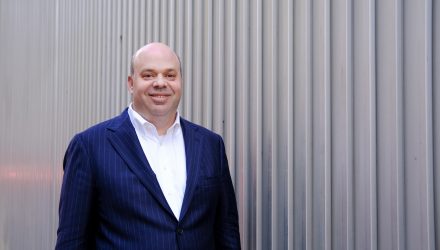DYNF actively selects large-cap stocks based on the rotation of the five traditional factors. Those are minimum volatility, momentum, quality, small size, and value. Index-based single or multi-factor ETFs make security-level changes every quarter or six months. However, the managers of DYNF can adjust the positions of the fund daily. As of January 24, the fund’s largest positions were Microsoft and Apple but also Home Depot and United Parcel Services.
In 2023, DYNF’s 36% total return was much stronger than the 26% gain for the iShares S&P 500 ETF (IVV). Year-to-date as of January 24, the active ETF’s 2.9% total return was ahead by 80 basis points.
BlackRock’s Growing Focus on Active ETFs
VettaFi interviewed Dominik Rohe, head of BlackRock’s Americas ETF and Index Investments business in November 2023. Rohe said then “Active ETFs are a growing part of the ETF landscape. They make up 38% of all ETFs in the U.S. and representing $101 billion in AUM. Lines are being blurred between active and index. ETFs are no longer simply the domain of low-cost indexes or transparent rules-based investing. They’re converging to become a technology to generate active return.”
DYNF charges a competitive 0.30% expense ratio that we believe leverages BlackRock’s scale as the largest U.S. and global ETF provider. We think the low fee combined with the performance record and the ability for new shares to be easily created on demand made the January 25 trading possible.
What Caused DYNF’s High Volume
The BlackRock active ETF traded heavily in four blocks during the afternoon on January 25. VettaFi has confidence that the moves were made by an institutional manager. We believed in late 2023 that BlackRock’s model portfolio solutions group managed close to $100 billion in assets. Advisors that work with third-party platforms like Envestnet have access to these risk-tailored models.
The amount collectively managed is large enough that when BlackRock makes a model move, we often see it days later in the ETF flow leaderboard. In addition, BlackRock tends to make allocation changes a few times a year. The last known move occurred three months ago. BlackRock has also submitted paperwork with the regulators to launch an active ETF run by its model portfolio solutions group.
Single-Factor ETFs Also Traded Heavily
On January 25, a few other factor ETFs saw well-above-average trading volume. We think these could have been sold to fund the trades into DYNF.
The iShares MSCI USA Quality Factor ETF (QUAL) has $38 billion in assets and was highly popular in 2023. QUAL gathered $11 billion, with more than half of the flows coming on March 20. Investors turned to QUAL given the earnings and macroeconomic uncertainty. QUAL owns companies with strong balance sheets and consistent earnings growth on a sector-neutral basis.
The quality ETF traded 1.2 million shares on average over the last 30 days as of January 24. However, QUAL traded 19 million shares on January 25 with nearly all occurring in one large trade late in the afternoon.
Min Vol Likely Remaining Out of Favor
Meanwhile, the iShares MSCI USA Min Vol Factor ETF (USMV) has $27 billion in assets. The ETF owns the least volatile stocks in each sector. Companies like Merck, IBM, and T-Mobile U.S. are among the top positions. In 2023, USMV had $5.5 billion of net outflows as investors favored taking on some equity market risk.
Over the last 30 days, DYNF traded infrequently. But on January 25, volume spiked and 53 million shares traded hands.
VettaFi thinks exposure to QUAL and USMV was reduced to fund the DYNF allocation. This was likely done in an efficient manner by market makers, since there’s overlapping underlying holdings in DYNF and these single factor ETFs. We know it could be days before VettaFi and other data providers show the full impact of these trades. However, we wanted to make sure investors had some insights into why DYNF gained popularity.
For more news, information, and analysis, visit VettaFi | ETF Trends.
